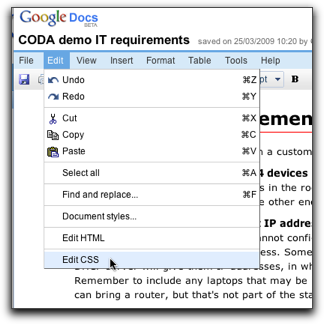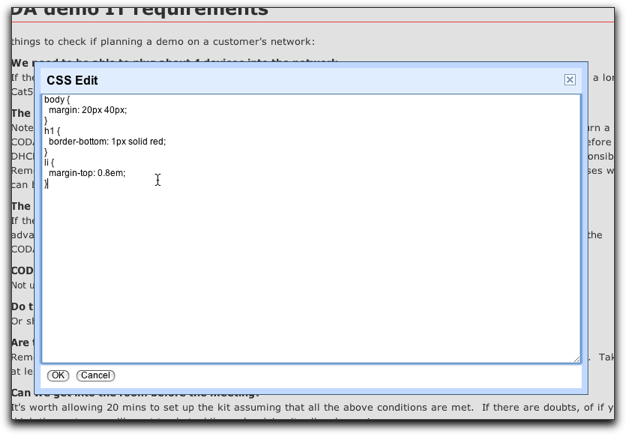…to discover that the Childwickbury goats’ cheese made by my step-sister Elizabeth was served as the vegetarian starter for the G20 leaders last night.
Glad to know Jamie approves of it…

We’re very proud too!…
…to discover that the Childwickbury goats’ cheese made by my step-sister Elizabeth was served as the vegetarian starter for the G20 leaders last night.
Glad to know Jamie approves of it…

We’re very proud too!…
On the Today program this morning, someone was saying that ISPs should be held partly responsible for movie and music piracy by their users, in the same way that a house owner should be responsible if the house was being used as a drug den.
But surely that’s the wrong analogy. People don’t in general upload the pirated material to the ISPs’ servers – they have it on their own PCs. Holding the ISP responsible is like blaming the local council because their roads were used to transport the drugs. Why not blame the electricity company that powers the PC?
The culpable ones, if any, are those who share material from their PCs. The media industries can’t sue all of them, though, so they have to find another scapegoat.
Last week a British vehicle set a new land speed record for wind-powered vehicles. 126.1mph.
Not the easiest thing to park at Waitrose, perhaps, but very pretty.
From the RosenblumTV blog:
Media Life reports this week that the average American now spends 8.5 hours a day staring at some kind of screen, whether its television, computer or cellphone.
…
This means that screenwatching has now become the number one human activity, surpassing even sleep. We will spend more of our lives staring at screens than doing anything else.Screenwatching has become the seminal and defining act of our culture.
I wonder what this will look like in three years’ time…
I’m a huge fan of Google docs – especially where several people need to collaborate on a document. But sometimes the formatting capabilities can be a little restricting – margins, line spacing, etc – you have little control over those.
Or so I thought, until this morning I discovered the ‘Edit CSS’ menu option:

With a little bit of CSS you can change the appearance in all sorts of ways. My needs are mostly simple, though.

Similarly, you can edit the HTML in various ways. I needed a line break as opposed to a paragraph break. Right click and you can Insert HTML at Selection. Type <br /> and you’re done.
I hope they teach raw HTML and CSS in schools these days. It’s the punctuation of the future. Not that they teach punctuation any more…
I got an email from Richard Branson this morning. Well, all right, I don’t think he personally sat down and typed it, unable to resist the urge to tell me about my particular cable modem connection, but he seemed pretty excited. Here’s an extract:
With the launch of our 50Mb broadband this year, the possibilities are virtually limitless. Who knows what speeds we’ll be able to bring to you in the future. But rest assured – since you’re on the fibre optic network, you’re on the right network.
With fibre optic technology the possibilities are virtually limitless.
On top of almost infinite speeds, there’s the simply brilliant things that only fibre optic broadband brings. Right now, you’re already getting unlimited downloads and free internet security. But we’re about to bring you more.
and he goes on to talk about backups, file-sharing and so on.
All this is possible thanks to the power of fibre optic broadband.
What amuses me is the claim that things like ‘free internet security’ and ‘backups’ are only possible over fibre-optic networks, especially when the cable that comes into my house is quite clearly made of copper. I suppose their point is that all those bits of copper connect in the end to a fibre backbone, but isn’t the same true of DSL? I guess that a truthful statement might be:
All this happens a bit faster thanks to the fact that our fibre/copper transceivers are placed closer to your premises than most of our competitors’ and we use coax rather than twisted-pair for the last bit.
But that wouldn’t have the same marketing punch, would it?
Anyway – this rings a little hollow at the moment. I’ve been a happy Virgin Media customer for many years. The service (which they bought from NTL) has been fast and reliable… until a few months ago when things seemed to get somewhat wobbly. And in the last couple of weeks we’ve had to reboot our cable modem rather too often for comfort. Reports of VM’s experimentation with traffic shaping may or may not have anything to do with this, but it’s not just my connection – in the office we’ve gone as far as getting an ADSL line installed to see if that gives us a better connection.
The great thing about ADSL, for all its technical limitations, is that it’s a more open market. Once the BT man had visited to connect up the wire, we had a choice of who would actually provide the broadband service. It may be a bit slower, but it should be more predictable – we could call up small companies where you could speak to someone who knew about contention ratios, and the effect that different latencies would have on our VOIP codecs. The experiment starts next week, so it’ll be interesting to see how it goes.
But in our case it may prove that a choice of informed, personal support services was the disruptive technology that even the amazing fibre optic network failed to deliver…
Google have announced, but not yet launched, Google Voice, which is an expansion of the GrandCentral service they purchased a couple of years back. Think of it as a cross between your company phone exchange and Google Mail.
I have a GrandCentral account – seldom used at present, as it’s very US-centric. But it gives me one US phone number which I can choose to manage in many different ways through a convenient web interface – I can, for example, redirect it to a friend’s house if I’m staying with them, or to a softphone, or to a US mobile, or have it ring all of the above and email me a voicemail message if nobody answers any of them.
It’s a great service, and GrandCentral users have worried what would become of it since it passed into Google’s hands. So I’m pleased to hear that it’s being reborn – I hope, and expect, they will now have the resources to make it more international.
And I can’t help wondering if this might be a very key component of Android-based phones in future.
I’m about half-way through Ben Goldacre’s splendid book ‘Bad Science’, which talks about clinical trials, homeopathy, the subtleties of the placebo effect, the supposed benefits of antioxidants, and a range of other topics, and does so in a most enjoyable way. He exposes some of the real science, and some of the nonsense, behind what is reported in the media.
Ben is a doctor who works for the NHS, has a column in The Guardian, and a web site at badscience.net. To get a feel for his work, have a look at his analysis of some recent feel-good reports in the papers and, worryingly, in Parliament. He begins:
“”Seven hundred British troops seized four Taliban narcotics factories containing £50m of drugs”” said the Guardian on Wednesday. “”Troops recovered more than 400kg of raw opium in one drug factory and nearly 800kg of heroin in another.”” Lordy that is good. In the Telegraph, British forces had seized “”£50 million of heroin and killed at least 20 Taliban fighters in a daring raid that dealt a significant blow to the insurgents in Afghanistan.”” Everyone carried the good news. “”John Hutton, defence secretary, said the seizure of £50m of narcotics would ‘starve the Taliban of funding preventing the proliferation of drugs and terror in the UK’.””
Well.
And then he looks at the real numbers. Read the post here.
Michael took some great photos of the Counterfeit Guest launch party. Thanks Michael!
Amazon have just released the Kindle software for the iPhone/iTouch. It’s only available to US customers, but I have a US credit card so was able to download it. This means I can now get any of 240,000 books on my iPod, within a few seconds.
And the reading experience is pretty good: there’s not much text visible at once in the standard font size, but a slight swipe of thumb or finger is all that’s needed to turn the page. Mmm. This could prove expensive.
No prizes for guessing which book I downloaded first, though! (Kindle version)
Nice quote from Ben Goldacre’s book Bad Science:
But these are just stories, and the plural of anecdote is not data.
© Copyright Quentin Stafford-Fraser
Recent Comments